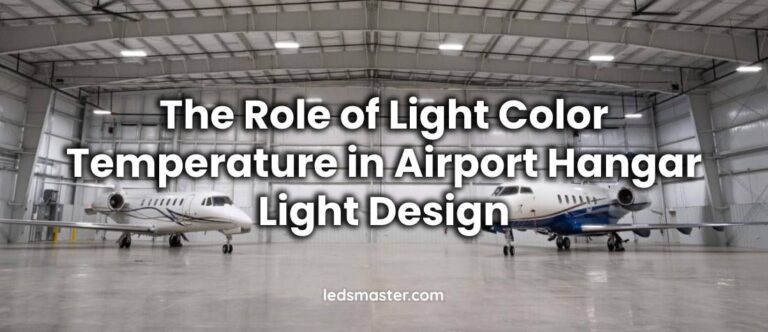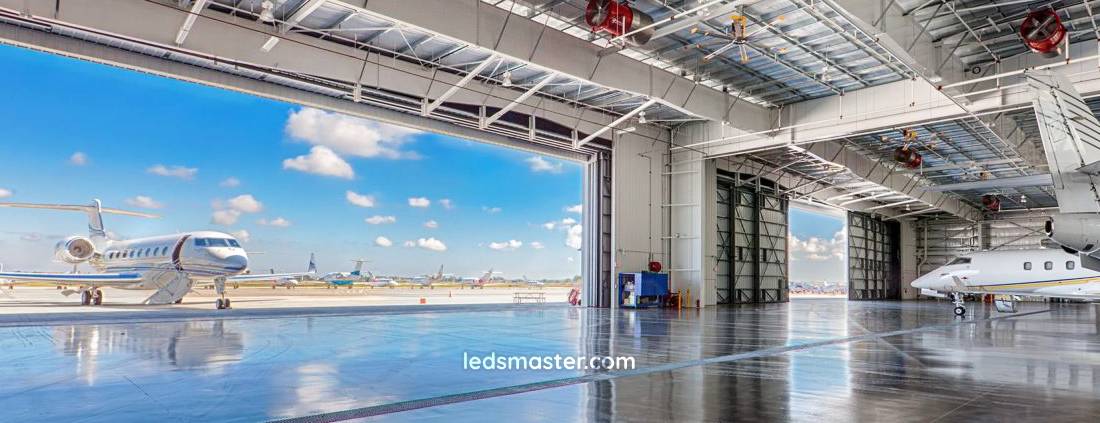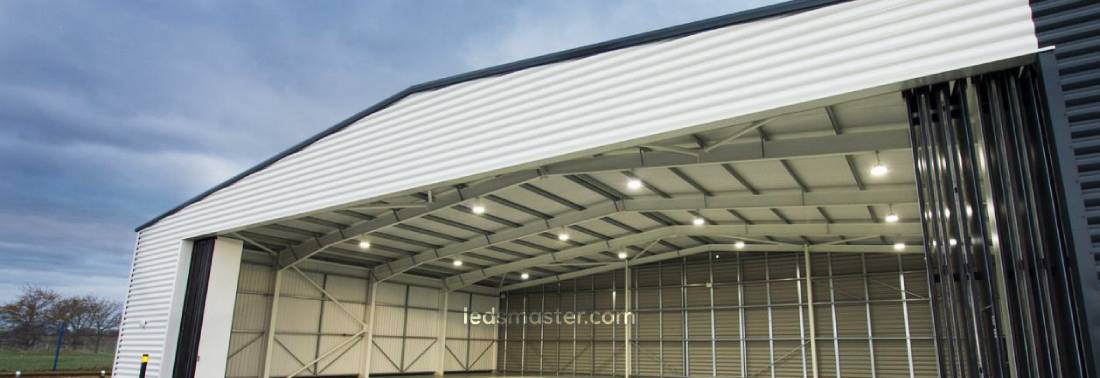
Discover how choosing the right color temperature for your hangar lighting can transform safety, boost productivity, and make every task easier. Ready to shine a light on the perfect lighting setup for your hangar? Let’s dive in!
Get your complimentary lighting design today
The color temperature of a light source influences how objects appear, how comfortable a space feels, and even how well tasks are performed. This article will explore the ideal color temperature for hangar lighting, the role it plays in safety and productivity, and how to match the color temperature to specific tasks in a hangar environment.
Table of Contents
ToggleThe ideal color temperature for hangar lighting typically falls between 4000K and 6000K. Color temperature, measured in kelvins (K), determines whether a light source emits a warm (yellowish) or cool (bluish) light.
For hangars, which are industrial spaces requiring clarity and precision, a cooler light in the range of 4000K to 6000K provides the best visibility. At 4000K, the light is described as neutral white, while 5000K to 6000K produces a daylight-like effect that mimics natural sunlight. This is particularly beneficial in large spaces where high visibility is essential for the safety and effective functioning of various activities, such as aircraft maintenance and inspection.
Color temperature directly influences the overall atmosphere of the hangar and the effectiveness of the work being carried out. A cooler light not only improves visual clarity but also enhances concentration and alertness. In a high-stakes environment like a hangar, where precision is required, poor lighting can lead to mistakes, safety hazards, and decreased productivity.
Hangars are typically bustling with activities such as aircraft assembly, repair, and inspections, which require workers to identify small details and perform complex tasks. If the lighting is too warm (below 3500K), it can create a cozy or relaxing atmosphere, which is not conducive to the fast-paced and detail-oriented environment of a hangar. Cooler lighting, on the other hand, keeps workers alert and reduces eye strain, contributing to both safety and efficiency.
Furthermore, color temperature can impact the perception of depth, shadows, and contrasts, which are vital for activities like inspecting aircraft parts. Poorly lit areas can lead to oversights that may compromise safety. By selecting the correct color temperature, the workspace becomes well-lit and conducive to both the safety and accuracy required in hangar operations.

Different tasks within a hangar may require variations in color temperature. While the general lighting across the hangar may fall within the 4000K to 6000K range, certain specialized areas or tasks might benefit from adjustments in color temperature.
In aircraft inspection areas, where workers need to assess and check for the smallest of defects, using a cooler light of 5000K to 6000K is ideal. This light replicates daylight and provides sharp, clear visibility, reducing the chance of missing critical details. It allows for better color rendering and improves the ability to spot irregularities, rust, or wear and tear on aircraft components.
For maintenance and repair zones, where workers need to focus on precision tools and machinery, a slightly warmer light within the 4000K to 5000K range may be preferable. This range provides enough brightness for detailed work without causing discomfort from excessive glare. It also strikes a balance between clarity and comfort, ensuring technicians can work for extended periods without experiencing eye strain.
In storage or utility areas of the hangar, where visibility is still important but not as critical as in maintenance or inspection zones, a color temperature of around 3000K to 4000K can be sufficient. This slightly warmer light provides enough illumination to navigate the space, while reducing energy costs compared to brighter, cooler lighting.

One of the most critical tasks in a hangar is inspecting the surface of aircraft for signs of damage or defects. The color temperature of the lighting used during these inspections plays a significant role in ensuring that no detail goes unnoticed.
A color temperature of 5000K to 6000K is optimal for these inspections because it enhances visibility and ensures that colors are accurately rendered. This is important when detecting wear, corrosion, or small cracks in the aircraft’s exterior. Cooler light not only ensures that these potential hazards are identified quickly but also improves the overall quality of the inspection process. By using lighting that mimics natural daylight, inspectors can rely on their eyes to pick up subtle differences in texture and appearance that might otherwise be missed under warmer, less intense lighting.
While color temperature plays a critical role in the effectiveness of hangar lighting, it is also important to consider energy efficiency when choosing lighting solutions. LED lights, which are commonly used in hangars, offer both energy savings and the ability to choose specific color temperatures.
LED technology allows for more precise control over color temperature, offering hangar operators the flexibility to adjust lighting based on the tasks being performed. Additionally, LEDs consume far less energy than traditional lighting options such as fluorescent or metal halide fixtures, reducing operational costs while still providing excellent visibility. Even at higher color temperatures (5000K to 6000K), LEDs remain energy-efficient, making them a popular choice for large spaces like hangars where lighting is often required for long hours.
While cooler color temperatures improve visibility and safety, they can also cause discomfort if too harsh. A balance between task lighting and ambient lighting can help reduce glare and provide a more comfortable working environment.
In some cases, hangar managers may opt for tunable lighting systems, which allow the color temperature to be adjusted based on specific needs. For instance, during early morning or late-night shifts, a slightly warmer color temperature might be preferred to create a more comfortable environment, while still maintaining sufficient brightness for tasks. Tunable systems provide flexibility and can adapt to the varying needs of workers over the course of the day.
Color temperature doesn’t just impact visibility—it can also influence mood and productivity. Cooler lighting (5000K and above) tends to create an alert, focused environment, making it ideal for high-stress and high-concentration tasks typically found in hangars. On the other hand, warmer lighting can evoke feelings of relaxation and comfort, which is not ideal in fast-paced, technical environments.
In hangars, where the primary focus is on efficiency and precision, maintaining cooler light temperatures throughout the workspace ensures that workers remain alert and productive. It also helps create a sense of professionalism and urgency, which is important when handling aircraft and working on time-sensitive projects.
Choosing the right color temperature for hangar lighting is essential for creating a safe, productive, and efficient workspace. With ideal color temperatures ranging from 4000K to 6000K, hangar operators can ensure their lighting meets the demands of various tasks, from maintenance to inspection. By balancing the color temperature with energy efficiency and visual comfort, and understanding the psychological impact of lighting, hangar managers can optimize their lighting setup for both performance and cost-effectiveness. Ultimately, selecting the right color temperature will not only enhance safety but also contribute to smoother operations in the hangar environment.